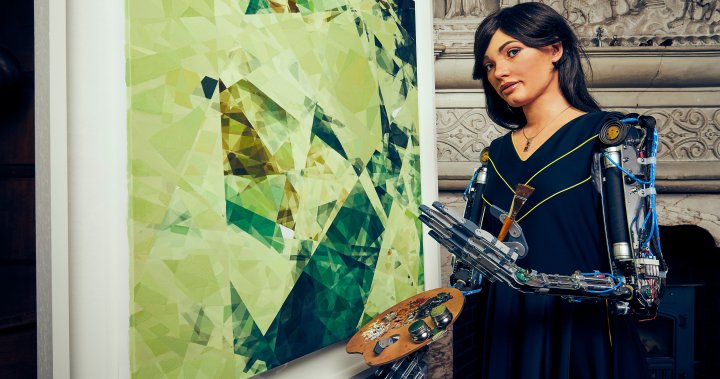
Behind every Trader Joe’s sign is a working artist who painted it
Each of the idiosyncratic grocery store’s 500-plus locations has custom-made signage, created by staff artists
So she studied education in college and, after moving to the United States in 2008, taught Korean — that is, until a curious job listing caught her eye.
An ocean away, Terrell called her dad with surprising news: “Hey, guess what, Dad? Now, drawing is going to feed me,” she recalls with a laugh.
Terrell is one of hundreds of sign artists employed by grocery store Trader Joe’s. You probably know the idiosyncratic chain for its eccentric snacks and peppy cashiers, but that festive atmosphere extends to the stores’ interior design, too: Each of the 500-plus outposts has custom, handmade signage, all created by staff artists. Your grocery store is their art gallery.
As what Trader Joe’s calls a “crew member with sign making talent” (we’ll just call them sign artists), Terrell, 40, spends much of her workday at the Athens, Ga., store wielding a paint pen in a backroom studio. She makes signs to promote products with puns like “Hot Grill Summer” and creative drawings such as the Powerpuff Girls reimagined as vegetables. She paints murals that represent the local area, University of Georgia sports teams or the surrounding rural landscape. Occasionally, she gets to incorporate Korean lettering into her work, such as when the store got a shipment of scallion pancakes known as “pajeon.” That was a highlight for Terrell — Korean students told her that seeing the Hangul writing made them feel a little more at home.
Terrell says that in her early days in the United States, she sorely missed Korean grocery stores, where employees knew her family and each store had its own character.
“Especially when I moved to the U.S., everything seemed like it had been kind of standardized. You go to Walmart in New York or you go to Walmart out in the boonies in Georgia, and they look exactly the same,” she says. “Trader Joe’s is just throwing a totally different curveball. It’s definitely more personable, and most of all, it’s just fun for me to look at something different.”
Trader Joe’s calls itself a “national chain of neighborhood grocery stores.” And everything seems to have a human touch: from sweeping murals of local landmarks, which can stay on view for years, all the way down to individual price tags telling you that clementines are $5.99 and “great for the road!” But for the artists, the work isn’t just about selling produce or marketing the latest peppermint-coated, jalapeno-infused, almond-butter-filled whatever. It’s a way to channel their artistic energy in a world that doesn’t make being creative easy. While job postings list pay for sign artists starting as low as $14 an hour, for many, it’s the stable art job they never thought they’d have.
“I always tell everybody, it’s probably the best entry-level artist position that has a steady paycheck, good benefits and everything,” says Dan Kaufeldt, a 35-year-old sign artist in Sacramento, who has been with the company for 16 years.
Kaufeldt’s store decor combines comic book energy with meticulous detailing. For Thanksgiving, he painted a smooth-looking Turkey named DJ Gravy Grav who mixes “All about that Baste” on a turntable, while spring break this year inspired an image of a cartoon lemon, strawberry and potato going on a road trip in a bouncing, orange RV.
For many Trader Joe’s sign artists, going all out is part of the fun. At one of the Philadelphia stores, McKinna Salinas, 25, is working on transforming the bathroom into a parody of the Philadelphia Museum of Art, inspired by works from the museum collection such as Severin Roesen’s “Flower Still Life With Bird’s Nest.” In her version of Winslow Homer’s “The Life Line,” a man is seen dangling above stormy seas — but instead of saving a woman, he’s saving a carrot.
Working at Trader Joe’s was the refresher Salinas needed after studying art at the University of California at Davis. “Right after graduating, I was really burned out. I think Trader Joe’s helped me get back into creating my own art,” she says. “It was enough to get my hands back into the motion of painting and creating.” On her own time, Salinas makes art based on environmental research and data. “Since at work I’m like, drawing corn, it pushes me to be even more creative and abstract at home.”
But Kaufeldt says there’s serious creativity in the store work, too, and he likens it to pop art. “Taking an iconic Trader Joe’s item, like a can of corn and then turning it into an art piece — it’s kind of like Andy Warhol,” he says. Kaufeldt left art school because it was too expensive, but working at Trader Joe’s was a welcome, if unexpected, alternative: “Where else can I just sit down and draw all day?”
Probably not many other places. While so much commercial art has been digitized, it might seem absurd that Trader Joe’s still pays people to hand-draw cartoons of dancing potatoes to sell a new type of chips. But Trader Joe’s didn’t woo its loyal fan base by being ordinary.
Founded by entrepreneur Joe Coulombe in 1967 and now privately owned by a notoriously secretive German family, the grocery store is almost an anti-brand. Trader Joe’s rarely advertises. It doesn’t have coupons. It avoids the words “sale” or “cheap.” The atmosphere is deliberately friendly. Crew members are trained to maximize interaction with customers by say, suggesting a wine or digging through the freezers to help find your favorite frozen food. At the register, the cashiers are famously chatty.
As for the signs, “the handcrafted quality emphasizes the personal relationship,” says Mark Gardiner, a former marketing executive who worked at Trader Joe’s while researching his book “Build a Brand Like Trader Joe’s,” which unpacks how the chain attracted a cultlike following. “It’s the graphic equivalent of that cheerful conversation that you’ll have with a total stranger that’s working there, who sees you buying dog food and asks you what kind of dog you have.”
While working at the downtown Minneapolis Trader Joe’s, Georgia Gump took that idea to its extreme: The 25-year-old artist made a window mural featuring the neighborhood’s dogs. It was a big hit.
But for Gump, who left the store in May, the early excitement of working at Trader Joe’s faded fast. That particular Minneapolis store is now trying to unionize for better wages and benefits (a store in Hadley, Mass., became the first Trader Joe’s to unionize last month), and Gump says it has been plagued by bad management. Gump hit a breaking point after breezing through the installation of an elaborate, handcrafted Christmas village.
“At first I was really excited that I did it in less than two hours,” Gump says. “Then, it hit me that installing this piece of art cost the company less than $30.”
Trader Joe’s declined to comment when asked specifically about pay issues but said in an earlier statement, “Each of our Crew Members engages with all aspects of the job, from stocking shelves and running a cash register, to corralling shopping carts and bagging groceries (and so much more!).” A recent job posting for a crew member “with sign-making talent” at a D.C. store listed a $17-an-hour rate, barely above the city’s $16.10 minimum wage.
“A lot of people don’t understand that art is hard work. It’s labor,” Gump says. “One of the lines that I get that I find eternally frustrating is, ‘You’re so talented.’ I wasn’t born being able to do what I can do now.”
On that front at least, working at Trader Joe’s has served some artists well. During their time there, many say, their designs got cleaner, their work became more professional and they found they could produce art more quickly. It even helped Madi Strubing fight creative blocks.
“I definitely have those days where I don’t have any creativity,” says Strubing, 20, who attends community college while working at a Trader Joe’s in Santa Cruz, Calif., and hopes to become an animator. “But then having to go to work and kind of being forced to draw helps.”
Some artists have used the job as a jumping-off point. Gump now does sign commissions and pet portraiture around town. Salinas recently made a piece for NASA that will be featured on a satellite. Terrell says, “Trader Joe’s became my self advertisement.”
“My dream 10 years ago was that I wanted to be the sign art person in Athens, Georgia,” she adds. “If some business needs a sign, my name would be the first name that comes to their mind.”
Recent commissions making menus for local bars and brunch spots suggest Terrell is well on her way. These days, drawing isn’t just feeding her. You could say it’s feeding Athens, too.





